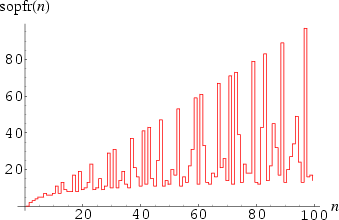
Let ![]() be the sum of prime factors (with repetition) of a number n. For example,
be the sum of prime factors (with repetition) of a number n. For example, ![]() ,
,![]() .
.![]() for n = 1, 2, ... is given by 0, 2, 3, 4, 5, 5, 7, 6, 6, 7, 11, 7, 13, 9, 8, ... (Sloane's A001414). The sum of prime factors function is also known as the integer logarithm.
for n = 1, 2, ... is given by 0, 2, 3, 4, 5, 5, 7, 6, 6, 7, 11, 7, 13, 9, 8, ... (Sloane's A001414). The sum of prime factors function is also known as the integer logarithm.
The high-water marks are 0, 2, 3, 4, 5, 7, 11, 13, 17, ..., which occur at positions 1, 2, 3, 4, 5, 7, 11, 13, 17, ... (Sloane's A046022), which, with the exception of the first term, correspond exactly to the actual values of the high-water marks.
If ![]() is considered to be 0 for p a prime, then the sequence of high-water marks is 0, 4, 5, 6, 7, 9, 10, 13, 15, 19, 21, 25, 31, 33, ... (Sloane's A088685), which occur at positions 1, 4, 6, 8, 10, 14, 21, 22, 26, 34, 38, 46, 58, ... (Sloane's A088686). Rather amazingly, if the first 7 terms are dropped, then the last digit of the high-water marks a and the last digit of their positions b fall into one of the four patterns
is considered to be 0 for p a prime, then the sequence of high-water marks is 0, 4, 5, 6, 7, 9, 10, 13, 15, 19, 21, 25, 31, 33, ... (Sloane's A088685), which occur at positions 1, 4, 6, 8, 10, 14, 21, 22, 26, 34, 38, 46, 58, ... (Sloane's A088686). Rather amazingly, if the first 7 terms are dropped, then the last digit of the high-water marks a and the last digit of their positions b fall into one of the four patterns ![]() ,
,
Now consider iterating ![]() until a fixed point (which will either be 0 or a prime) is reached. For example, 20 would give the sequence 20, 9, 6, 5, 5, .... The fixed points for n = 1, 2, ... are then given by 0, 2, 3, 4, 5, 5, 7, 5, 5, 7, 11, 7, 13, ... (Sloane's A029908), and the lengths of the corresponding sequences are 2, 1, 1, 1, 1, 2, 1, 3, 3, 2, 1, 2, 1, 4, ... (Sloane's A002217).
until a fixed point (which will either be 0 or a prime) is reached. For example, 20 would give the sequence 20, 9, 6, 5, 5, .... The fixed points for n = 1, 2, ... are then given by 0, 2, 3, 4, 5, 5, 7, 5, 5, 7, 11, 7, 13, ... (Sloane's A029908), and the lengths of the corresponding sequences are 2, 1, 1, 1, 1, 2, 1, 3, 3, 2, 1, 2, 1, 4, ... (Sloane's A002217).
Now consider the restricted sums of the iteration lists after discarding the initial term. For example, 20 would give ![]() .
.
The similar function ![]() giving the sum of distinct prime factors of n can also be considered. For n = 1, 2, ..., this function has the values 0, 2, 3, 2, 5, 5, 7, 2, 3, 7, 11, 5, ... (Sloane's A008472).
giving the sum of distinct prime factors of n can also be considered. For n = 1, 2, ..., this function has the values 0, 2, 3, 2, 5, 5, 7, 2, 3, 7, 11, 5, ... (Sloane's A008472).
![]()
![]()
![]()
Sloane, N. J. A. Sequences A001414/M0461, A002217/M0150, A008472, A029908, A046022, A088685, and A088686 in "The On-Line Encyclopedia of Integer Sequences." http://www.research.att.com/~njas/sequences/.